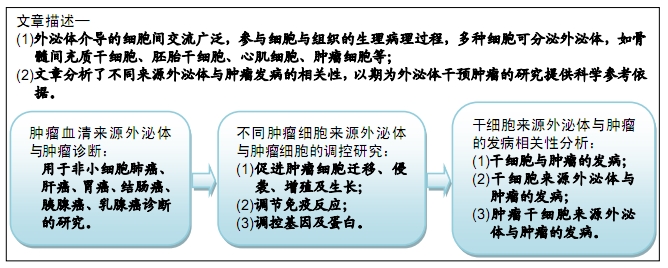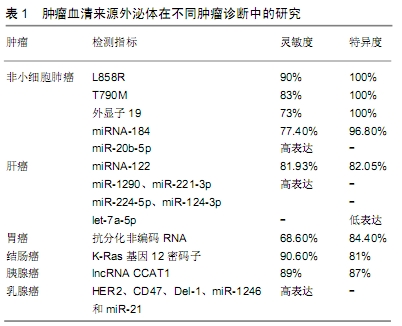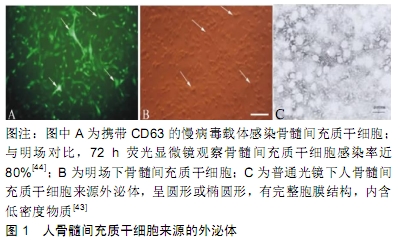[1] COLOMBO M, RAPOSO G, THÉRY C. Biogenesis, secretion, and intercellular interactions of exosomes and other extracellular vesicles. Annu Rev Cell Dev Biol. 2014;30:255-289.
[2] 刘洁,万璐,戎柯纬,等.外泌体在病毒感染中的作用[J].华中科技大学学报(医学版), 2019,48(1):104-108.
[3] RAPOSO G, NIJMAN HW, STOORVOGEL W, et al. B lymphocytes secrete antigen-presenting vesicles. J Exp Med. 1996;183(3): 1161-1172.
[4] CORRADO C, RAIMONDO S, CHIESI A, et al. Exosomes as intercellular signaling organelles involved in health and disease: basic science and clinical applications. Int J Mol Sci. 2013;14(3):5338-5366.
[5] SHARMA A. Role of stem cell derived exosomes in tumor biology. Int J Cancer. 2018;142(6):1086-1092.
[6] YU X, ODENTHAL M, FRIES JW. Exosomes as miRNA Carriers: Formation-Function-Future. Int J Mol Sci. 2016;17(12): E2028.
[7] CASTELLANOS-RIZALDOS E, ZHANG X, TADIGOTLA VR, et al. Exosome-based detection of activating and resistance EGFR mutations from plasma of non-small cell lung cancer patients. Oncotarget. 2019;10(30):2911-2920.
[8] 魏萍,杜鲁涛,王卿,等.血清外泌体miR-20b-5p对非小细胞肺癌的诊断价值[J].山东大学学报(医学版), 2019,57(4):91-96.
[9] 刘玉山,闫红江,李春雨.血清外泌体miRNA-184在非小细胞肺癌中的表达水平及其诊断效能[J].癌症进展, 2019,17(4):411-414.
[10] 高斌,熊莹晖,黄泽炳,等.乙肝相关性肝细胞癌患者血清外泌体miR-1290水平的变化及其诊断价值[J].中国普通外科杂志, 2019,28(1):31-38.
[11] 张云,庹敏,刘胜武.血清外泌体来源的miRNA-122对肝癌诊断的研究[J].检验医学与临床, 2017,14(9):1260-1261.
[12] 纪奇峰,祝春来,王伟,等.肝细胞癌患者血清外泌体microRNA表达鉴定[J].现代生物医学进展, 2018,18(22):4213-4218.
[13] 李阳,潘磊,梁炜,等.胃癌患者血清外泌体中DANCR表达及其临床意义[J].临床检验杂志, 2017,35(3):171-174.
[14] 崔琮,靳杨,谭招丽,等.结直肠癌患者血清外泌体代替肿瘤组织检测K-Ras基因突变的研究[J].临床肿瘤学杂志, 2017,22(5):395-399.
[15] TOMASETTI M, LEE W, SANTARELLI L, et al. Exosome-derived microRNAs in cancer metabolism: possible implications in cancer diagnostics and therapy. Exp Mol Med. 2017;49(1):e285.
[16] HOSSEINI M, KHATAMIANFAR S, HASSANIAN SM, et al. Exosome- Encapsulated microRNAs as Potential Circulating Biomarkers in Colon Cancer. Curr Pharm Des. 2017;23(11):1705-1709.
[17] 任潇凡,李志花.外泌体lncRNA CCAT1在胰腺癌中的表达及其临床意义[J].岭南现代临床外科, 2019,19(1):23-27.
[18] 王爱红,赵菊梅,王明全. PD-1、CTLA-4和MMP9在伴或不伴淋巴结转移乳腺癌患者外泌体中的表达[J].现代免疫学, 2019,39(2):110-114.
[19] WANG M, JI S, SHAO G, et al. Effect of exosome biomarkers for diagnosis and prognosis of breast cancer patients. Clin Transl Oncol. 2018;20(7):906-911.
[20] XU W C, QIAN G, LIU A Q, et al. Urinary Extracellular Vesicle: A Potential Source of Early Diagnostic and Therapeutic Biomarker in Diabetic Kidney Disease. Chin Med J (Engl), 2018,131(11): 1357-1364.
[21] 陈群,吴飏,时国东,等.肿瘤来源的外泌体在肿瘤进展中的作用及其诊疗意义[J].南京医科大学学报(自然科学版), 2019,39(2): 300-305.
[22] 彭一琳,倪煦东,曹帆,等.前列腺癌细胞来源的外泌体诱导巨噬细胞极化[J].中国生物化学与分子生物学报, 2019,35(2): 179-186.
[23] 范维肖,雷琳,李蕊,等.前列腺癌LNCaP-AI+F细胞外泌体促进基质细胞WPMY-1功能活化[J].中国肿瘤生物治疗杂志, 2019, 26(3):293-298.
[24] 潘韵芝,马赛,曹凯悦,等.高表达ANXA2肝癌干细胞外泌体对肝癌细胞恶性生物学特性的调控作用[J].中国肿瘤, 2019,28(4): 308-314.
[25] 杨勇,陈霖,杨宏新,等.癌源外泌体的制备及其对胃癌细胞STK15表达的影响[J].重庆医学, 2019,48(9):1453-1456.
[26] 郭怡,彭红,蹇淑娟,等.口腔癌患者循环外泌体促进舌癌细胞CAL27增殖、迁移、侵袭中的作用[J].实用口腔医学杂志, 2019,35(1):60-65.
[27] LI I, NABET BY. Exosomes in the tumor microenvironment as mediators of cancer therapy resistance. Mol Cancer. 2019;18(1):32.
[28] 崔雅楠,张传霞,金浩范.肿瘤细胞来源的外泌体对NK细胞活性的影响[J].中国老年学杂志, 2019,39(6):1525-1528.
[29] 李雪,李楠.肝癌外泌体LINC ROR对巨噬细胞炎症反应的影响[J].四川大学学报(医学版), 2019,50(2):177-181.
[30] 章菊,叶书来,张昌龙,等.HepG2细胞外泌体冲击树突状细胞介导的抗肿瘤作用[J].癌变·畸变·突变, 2019,31(1):29-34.
[31] 冯慧洁,任伟宏,仝岩,等.胃癌源性外泌体对HLA-DR~(neg)leukocytes中Dicer1、PTEN基因的调控[J].免疫学杂志, 2017,33(3):203-207.
[32] 吕龙辉,黄晓悫,熊小明,等.鼻咽癌外泌体miR-20a通过靶向BCL2L11基因抑制肿瘤相关巨噬细胞凋亡[J].重庆医学, 2017, 46(6):721-724.
[33] ZHANG Y, YU G, CHU H, et al. Macrophage-Associated PGK1 Phosphorylation Promotes Aerobic Glycolysis and Tumorigenesis. Mol Cell. 2018;71(2):201-215.e7.
[34] HE Y, CHEN D, YANG L, et al. The therapeutic potential of bone marrow mesenchymal stem cells in premature ovarian failure. Stem Cell Res Ther. 2018;9(1):263.
[35] ENGLISH K, MAHON BP, WOOD KJ. Mesenchymal stromal cells; role in tissue repair, drug discovery and immune modulation. Curr Drug Deliv. 2014;11(5):561-571.
[36] CHEN J, JI T, WU D, et al. Human mesenchymal stem cells promote tumor growth via MAPK pathway and metastasis by epithelial mesenchymal transition and integrin α5 in hepatocellular carcinoma. Cell Death Dis. 2019;10(6):425.
[37] ZHANG TY, HUANG B, WU HB, et al. Synergistic effects of co-administration of suicide gene expressing mesenchymal stem cells and prodrug-encapsulated liposome on aggressive lung melanoma metastases in mice. J Control Release. 2015;209:260-271.
[38] 许峰,金晓霞,施民新.人骨髓间充质干细胞促进乳腺癌细胞系MCF7上皮间质转化[J].基础医学与临床, 2018,38(9): 1244-1250.
[39] 许鹏超,李静,赵春华.体外共培养人骨髓间充质干细胞与乳腺癌细胞可促进癌细胞的侵袭和迁移能力[J].基础医学与临床, 2016,36(5):615-620.
[40] 蒋东辉,黄博,张月飞,等.人骨髓间充质干细胞诱导鼻咽癌上皮间质化的初步探讨[J].中华肿瘤防治杂志, 2014,21(23): 1851-1855.
[41] 周昌宁,曹海宁,李利平.骨髓间充质干细胞促进结肠癌细胞HT29增殖和迁移[J].第三军医大学学报, 2015,37(7):649-654.
[42] 赵慧巧,卢年华,张旭东,等. 结肠癌微环境对HMSC-bm形态、增殖、周期及CD34、CD90的影响[J].中国细胞生物学学报, 2018,40(5):745-751.
[43] 冯影,卢士红,王昕,等.人骨髓来源间充质干细胞分泌外泌体特性研究[J].中国实验血液学杂志, 2014,22(3):595-599.
[44] 任瑞,谭晓红,鲁亚成,等.一种绿色荧光蛋白标记的骨髓间充质干细胞源性外泌体的构建及鉴定[J].神经解剖学杂志, 2017,33(2): 167-171.
[45] 袁林,曹依娜,杨征毅,等.人颌骨间充质干细胞的外泌体在巨噬细胞调控中的作用[J].实用口腔医学杂志,2017,33(3): 344-348.
[46] 韩睿,李琳,王润清,等.间充质干细胞来源外泌体对免疫功能调控的作用与应用前景[J].中国组织工程研究, 2019,23(17): 2762-2769.
[47] 王雪,刘芳.骨髓间充质干细胞来源的Exosome修复兔受损子宫内膜的研究[J].现代妇产科进展, 2018,27(3):170-174.
[48] 周政,杜波,范雪,等.骨髓间充质干细胞外泌体对SD大鼠早衰卵巢的影响[J].中国科技论文, 2018,13(12):1429-1433.
[49] 裴双,王琳,陈雪梅,等.骨髓间充质干细胞来源的外泌体静脉移植对脊髓损伤的修复作用[J].中国脊柱脊髓杂志, 2017,27(12):1119-1127.
[50] 林颖,胡锦章,颛孙永勋,等.骨髓间充质干细胞外泌体调节哮喘小鼠Foxp3~+ Treg/Th17的平衡[J].中国组织工程研究, 2018,22(17): 2637-2643.
[51] 綦惠,刘丹平,田大川,等.骨髓间充质干细胞源性外泌体对体外培养的软骨细胞增殖和迁移的调节作用[J].中国运动医学杂志, 2019,38(1):40-45.
[52] 张万松,杨诚,郭文彬,等.BMSCs来源的外泌体对大鼠睾丸缺血再灌注损伤的保护作用[J].南方医科大学学报, 2018,38(8): 910-916.
[53] SASAHIRA T, KIRITA T. Hallmarks of Cancer-Related Newly Prognostic Factors of Oral Squamous Cell Carcinoma. Int J Mol Sci. 2018;19(8): E2413.
[54] MAO L, LI J, CHEN WX, et al. Exosomes decrease sensitivity of breast cancer cells to adriamycin by delivering microRNAs. Tumour Biol. 2016;37(4):5247-5256.
[55] SHARMA A. Role of stem cell derived exosomes in tumor biology. Int J Cancer. 2018;142(6):1086-1092.
[56] 张贺龙,杨俊辉,佘远岭,等.外泌体在胃癌中作用的研究进展[J].肿瘤, 2019,39(3):215-222.
[57] 王丹丹,陈建中,亢春彦.BMSCs来源的外泌体对小鼠乳腺癌细胞4T1增殖、侵袭的影响及机制探讨[J].山东医药, 2015,55(35): 12-15.
[58] YAN K, WU Q, YAN DH, et al. Glioma cancer stem cells secrete Gremlin1 to promote their maintenance within the tumor hierarchy. Genes Dev. 2014;28(10):1085-1100.
[59] VALLABHANENI KC, PENFORNIS P, DHULE S, et al. Extracellular vesicles from bone marrow mesenchymal stem/stromal cells transport tumor regulatory microRNA, proteins, and metabolites. Oncotarget. 2015;6(7):4953-4967.
[60] SALYBEKOV AA, SALYBEKOVA AK, POLA R, et al. Sonic Hedgehog Signaling Pathway in Endothelial Progenitor Cell Biology for Vascular Medicine. Int J Mol Sci. 2018;19(10): E3040.
[61] CHEN G, GOTO Y, SAKAMOTO R, et al. GLI1, a crucial mediator of sonic hedgehog signaling in prostate cancer, functions as a negative modulator for androgen receptor. Biochem Biophys Res Commun. 2011;404(3):809-815.
[62] 贾姗姗,李笑岩,滕菲,等.大鼠诱发型肝癌发生发展过程中Sonic Hedgehog、Ptc和Gli1表达的改变[J].中国组织化学与细胞化学杂志, 2013,22(3):207-211.
[63] 刘庆生,俞建顺,蔡丹莉,等.大鼠胃癌前病变形成过程中胃黏膜Sonic Hedgehog信号通路的变化[J].中国临床药理学与治疗学, 2018,23(7): 761-769.
[64] 陈浩,许浪.信号通路对胃癌干细胞及胃癌发生的影响[J].中国组织工程研究,2013,17(14):2532-2537.
[65] 刘志勇,易坚,邹小明.乳腺癌组织中Hedgehog相关蛋白的表达及其临床意义[J].肿瘤防治研究, 2014,41(7):756-761.
[66] 徐又海,汪兴洪.Shh、Gli1基因在多发性骨髓瘤中的表达及临床意义[J].中国临床药理学与治疗学, 2015,20(3):309-313.
[67] 许秋然,郑鑫,昝献峰,等.胶质瘤相关癌基因1在肝细胞癌中的表达及其与Shh、Vimentin、E-cad-herin蛋白的相关性研究[J].细胞与分子免疫学杂志, 2012,28(5):536-539.
[68] 郑晓文,陈一强,孔晋亮,等. Hedgehog信号通路成分SHH和Gli-1及血管内皮生长因子在人肺癌中的表达[J].中国全科医学, 2014,17(18): 2096-2102.
[69] 徐林汇,尹青青,张咪,等.组织芯片检测Hh信号通路相关蛋白在前列腺癌中的表达及临床意义[J].基因组学与应用生物学, 2018,37(6):2726-2730.
[70] 朱华民,李扬秋.实时定量PCR检测慢性粒细胞白血病患者Shh、Smo基因的表达水平[J].第三军医大学学报, 2014,36(3): 267-269.
[71] 林松挺,陈正义,钟文洲.SHH蛋白在胰腺癌组织中的表达及其临床意义[J].中国普通外科杂志, 2016,25(9):1266-1270.
[72] 赵志龙,张丽芳,张佳,等.Shh与MMP2在人食管鳞癌组织中的表达及意义[J].南方医科大学学报, 2013,33(7):1008-1011.
[73] 沈冰,夏含笑,朱凌霄,等.鼻咽癌中Shh和Ptch1基因的表达及其临床意义[J].临床与实验病理学杂志, 2016,32(7):761-765.
[74] VAN DEN BRINK GR. Hedgehog signaling in development and homeostasis of the gastrointestinal tract. Physiol Rev. 2007;87(4): 1343-1375.
[75] LIN TC, WANG KH, CHUANG KH, et al. Modulation of tumor stem cell characteristics by 17β-estradiol in human mesenchymal stem cells derived from ovarian endometrioma. Taiwan J Obstet Gynecol. 2019; 58(3):338-344.
[76] PREUSSNER J, ZHONG J, LOOSO M, et al. Connect-four: genomic analyses of regenerating stem cells identifies zygotic Dux factors as tumor initiators. Mol Cell Oncol. 2019;6(2):1565469.
[77] 刘铁娥,于艳,戴广海.肺癌干细胞分泌外泌体增强肺癌细胞对化疗敏感性的研究[J].现代中西医结合杂志, 2019,28(15): 1622-1625.
[78] 张丹,何大维,李典,等.肿瘤样干细胞来源的外泌体促进人脐带间充质干细胞的增殖和侵袭[J].南方医科大学学报, 2018,38(12): 1440-1447.
[79] GIMPLE RC, BHARGAVA S, DIXIT D, et al. Glioblastoma stem cells: lessons from the tumor hierarchy in a lethal cancer. Genes Dev. 2019; 33(11-12):591-609.
[80] 徐峰,牛万祥,谢时帅,等.胶质瘤干细胞来源的外泌体对血管内皮细胞增殖和迁移的影响[J].国际神经病学神经外科学杂志, 2018, 45(5):443-447.
|



